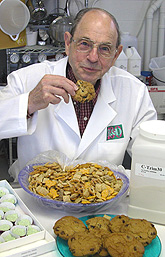This page has been archived and is being provided for reference purposes only. The page is no longer being updated, and therefore, links on the page may be invalid.
|
|
New Obesity-Fighting, Heart-Healthy Product Announced Today
By Jan SuszkiwAugust 29, 2005
At today's American Chemical Society (ACS) national meeting in Washington, D.C., Agricultural Research Service chemist George Inglett will serve cookies with his scientific presentation.
But Inglett isn't just buttering up his peers. Instead, he's unveiling Calorie-Trim, an all-natural, super-carb product he created to promote better consumer health. The cookies are among various C-Trim-containing foods available for sampling.
Derived from whole oats and barley, C-Trim contains 20 to 50 percent beta-glucan, a soluble fiber found in these grains. When eaten, the biologically active fiber helps the body regulate blood glucose and lower bad cholesterol, diminishing the risk of heart disease. C-Trim can mimic some fat and carbohydrates' properties in food without overburdening the body with calories that contribute to diabetes and obesity, according to Inglett, with ARS' National Center for Agricultural Utilization Research, Peoria, Ill.
At the Cereal Products and Food Science Unit there, C-Trim is the latest in a line of Trim technologies Inglett has developed to boost the health benefits of food. C-Trim, with less than four calories per gram, boasts five to 10 times more soluble fiber than regular milled oats, flour and oatmeal.
Inglett's presentation today will cover C-Trim's production, expected health benefits, and functional properties when added to food--such as to replace cocoa butter in dark chocolate--that doesn't contain beta-glucan. Ten other ARS presenters will discuss other facets of C-Trim, including taste-test results and blood-cholesterol trials with hamsters. Besides cookies, ACS attendees can try C-Trim trail mix, chocolate, smoothies and peanut butter.
In creating C-Trim, Inglett worked to avoid some of the drawbacks associated with existing methods of extracting beta-glucan from cereal grains. The drawbacks include using hard-to-reclaim chemical solvents, like isopropanol, and getting low yields of beta-glucan from grain slurries. Inglett's method integrates the use of mechanical shearing, centrifugation, steam-jet cooking and drum drying to extract and concentrate beta-glucan from the slurries.
FutureCeuticals of Momence, Ill., has licensed Inglett's method (patent application 11/020,349) from ARS, the U.S. Department of Agriculture's chief scientific research agency.

